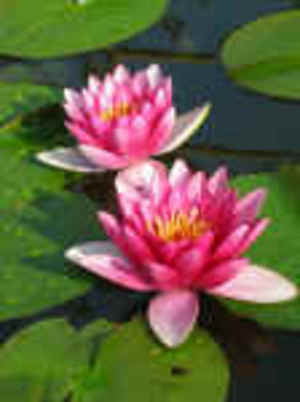A Garden Guide To Growing Water Lilies
Water lilies are the showy centerpiece of most professionally designed water gardens, but many backyard gardeners shy away from the aquatic plant. Though they appear fragile and exotic, water lilies are actually a simple way to add beauty to any backyard pond or water garden.
Choosing Varieties
Water lilies come in two types, hardy and tropical. Tropical water lilies can add a touch of the exotic to the southern water garden, with both day and night blooming varieties, but require water temperatures that remain above 70 degrees. Hardy water lilies are the preferred choice for most growers, because they thrive in most climates and environments, from the large waterscape to the whiskey barrel deck planter. All hardy varieties are day blooming. Dwarf varieties are also available for the small water garden.
Planting
Water lilies are purchased as tubers, which resemble the rhizome of an iris. These tubers grow horizontally, so the planting basket for a water lily should be at least 12″ to 18″ wide. If the basket you choose has drainage holes, line the basket with burlap to prevent soil from escaping through the holes when the basket is submerged.
Select a heavy soil mix, such as garden or topsoil, rather than a light potting mix that is likely to float out of the container. Water lilies are heavy feeders, and will not bloom unless they receive proper nutrition. Pressing several fertilizer tablets designed for water plants into the soil before planting will ensure a steady supply of nutrients for the entire growing season.
Before planting, examine the tuber and remove any old leaves or thick, fleshy roots, leaving only new buds and thin, new root growth. Plant the tuber at a near the edge of the basket, with the growing end positioned towards the center at about a 45 degree angle. Finally, spread a layer of pea gravel or stone around the plant to keep the soil in the basket as it is submerged.
Submerge the basket slowly, holding it at an angle to allow for air to escape. Water lilies should be planted at a depth of about 18″, but specific depth and spacing requirements vary greatly by variety, so be sure to check the plant tags when you purchase you plants to be sure you are selecting a variety that works for your space.
Pruning and Care
Water lilies are virtually care free during the growing season. They do not require routine pruning or fertilization, but pond water should be cared for and kept clear to promote healthy growth.
Winterizing water lilies is a simple process. The specific method you should use depends upon your climate. Regardless of the method, the first step is to remove dead any dying leaves, to prepare the plant for winter. If the pond where the plant is located will not freeze solid, lower the plant to the deepest part of the pond. If the pond does freeze or will be drained for the winter, remove the water lily, pot and all. Place the pot in a plastic bag to keep it moist, and store in a cool location. If you cannot store the potted plant, remove and clean the tuber, pack it in peat moss, and store in a location that will remain between 40 and 50 degrees.
In the spring, plants that were stored in their pot can simply be moved back to their growing position. Plants that were stored as tubers should be re-potted as though they were new plants.
Water lilies should be divided every few years to ensure continued growth. Spring is the ideal time for this division, in order to give freshly cut plants a full growing season to reestablish themselves. To divide water lilies, remove the plant from its pot and examine the root system. Using a sharp knife, divide the root into small sections, ensuring that each section contains a growing bud. Each of these sections can be potted to start a new water lily.
Reference:
- This article originally appeared at Garden & Hearth, where you can find more garden guides and a thriving gardening community. www.gardenandhearth.com Cultivation of Water Lilies – www.iamshaman.com/lotus/cultivation.htm




